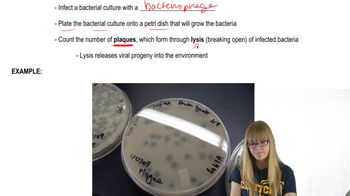How do high-throughput techniques such as computer-automated, next-generation sequencing, and mass spectrometry facilitate research in genomics and proteomics? Explain.
Table of contents
- 1. Introduction to Genetics51m
- 2. Mendel's Laws of Inheritance3h 37m
- 3. Extensions to Mendelian Inheritance2h 41m
- 4. Genetic Mapping and Linkage2h 28m
- 5. Genetics of Bacteria and Viruses1h 21m
- 6. Chromosomal Variation1h 48m
- 7. DNA and Chromosome Structure56m
- 8. DNA Replication1h 10m
- 9. Mitosis and Meiosis1h 34m
- 10. Transcription1h 0m
- 11. Translation58m
- 12. Gene Regulation in Prokaryotes1h 19m
- 13. Gene Regulation in Eukaryotes44m
- 14. Genetic Control of Development44m
- 15. Genomes and Genomics1h 50m
- 16. Transposable Elements47m
- 17. Mutation, Repair, and Recombination1h 6m
- 18. Molecular Genetic Tools19m
- 19. Cancer Genetics29m
- 20. Quantitative Genetics1h 26m
- 21. Population Genetics50m
- 22. Evolutionary Genetics29m
15. Genomes and Genomics
Proteomics
Problem 13
Textbook Question
The two-hybrid method facilitates the discovery of protein–protein interactions. How does this technique work? Can you think of reasons for obtaining a false-positive result, that is, where the proteins encoded by two clones interact in the two-hybrid system but do not interact in the organism in which they naturally occur? Can you think of reasons you might obtain a false-negative result, in which the two proteins interact in vivo but fail to interact in the two-hybrid system?
 Verified step by step guidance
Verified step by step guidance1
Step 1: Understand the two-hybrid method: This technique is used to detect protein–protein interactions by expressing two proteins of interest as fusion proteins in a host cell, typically yeast. One protein is fused to a DNA-binding domain (the 'bait'), and the other is fused to a transcriptional activation domain (the 'prey'). If the two proteins interact, the DNA-binding and activation domains come together to activate transcription of a reporter gene, indicating interaction.
Step 2: Consider the mechanism of detection: The interaction between bait and prey proteins reconstitutes a functional transcription factor that binds to a specific promoter upstream of a reporter gene. The expression of this reporter gene (e.g., lacZ or HIS3) provides a measurable readout of protein interaction.
Step 3: Identify reasons for false-positive results: False positives can occur if the bait or prey proteins autonomously activate transcription without interacting, if the fusion proteins misfold or aggregate, or if the interaction occurs only in the artificial environment of the assay but not in the natural cellular context. Additionally, overexpression of proteins can force non-physiological interactions.
Step 4: Identify reasons for false-negative results: False negatives may arise if the fusion proteins do not fold properly or localize correctly in the host cell, if post-translational modifications required for interaction are missing, or if the interaction depends on additional cofactors or cellular conditions absent in the assay system. Also, steric hindrance from the fusion domains can prevent interaction.
Step 5: Summarize the importance of controls: To validate results, it is essential to include controls such as testing bait and prey alone for autoactivation, using known interacting and non-interacting protein pairs, and confirming interactions with complementary methods to reduce false positives and negatives.
 Verified video answer for a similar problem:
Verified video answer for a similar problem:This video solution was recommended by our tutors as helpful for the problem above
Video duration:
2mPlay a video:
Was this helpful?
Key Concepts
Here are the essential concepts you must grasp in order to answer the question correctly.
Yeast Two-Hybrid System
The yeast two-hybrid system is a molecular biology technique used to detect protein–protein interactions by expressing two proteins of interest as fusion proteins in yeast. One protein is fused to a DNA-binding domain, and the other to a transcriptional activation domain. Interaction between the proteins reconstitutes a functional transcription factor, activating a reporter gene and indicating interaction.
Recommended video:
Guided course

Functional Genomics
False-Positive Results in Two-Hybrid Assays
False positives occur when proteins appear to interact in the assay but do not interact naturally. This can happen due to overexpression, non-physiological conditions, or interactions mediated by the fusion tags or yeast-specific factors, leading to artificial or indirect interactions not present in the native cellular environment.
Recommended video:
Guided course

Positional Cloning
False-Negative Results in Two-Hybrid Assays
False negatives arise when proteins that interact in vivo fail to show interaction in the assay. Reasons include improper folding or localization of fusion proteins, absence of necessary post-translational modifications, or the requirement of additional cofactors or cellular conditions not replicated in the yeast system.
Recommended video:
Guided course

Plaques and Experiments
Related Videos
Related Practice
Textbook Question
730
views


